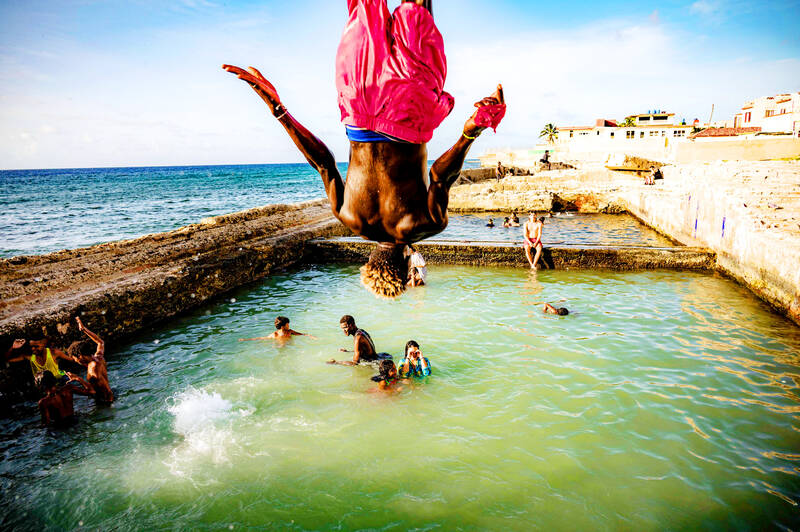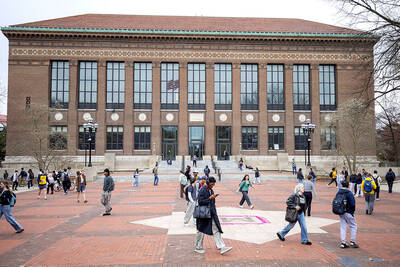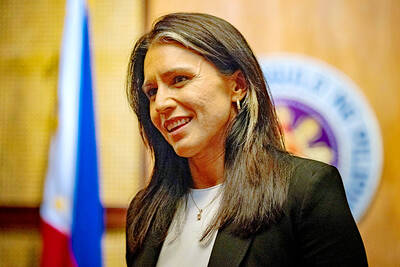When summer temperatures start to sizzle in Havana, in-the-know locals head not to the beach, but to seaside pools built by wealthy Cuban families in the first half of the last century.
Now abandoned and filled with seawater, the pools that survived the 1959 revolution are in the western Havana neighborhood of Miramar that flourished in the 1940s and 1950s with lavish mansions and luxury hotels.
“These swimming pools are a tradition. From generation to generation, we come here,” said Boris Baltrons, 44, accompanied by his daughter, sister and nephew.

Photo: AFP
“These houses belonged to rich people. At the time, everyone had their own little pool,” he said, pointing to traces of Spanish tiles that originally lined the walls.
Known only to locals, the pools are at the end of a rubbish-strewn walk. Swimmers sometimes share the pools with fish, crabs and even small octopuses.
“It’s not a beach like Varadero, but children can have fun here,” said Alberto, a 38-year-old scientist, referring to the seaside resort east of the capital.
He came on foot with his family, before sunset, to take a dip in one of the open-air swimming pools.
Havana’s closest sandy beaches are about a 20-minute drive away, a luxury not everyone can afford on the communist island where fuel shortages are common. Many of Cuba’s swimming pools that require fresh water have fallen into oblivion, including ones built within sports facilities during the first decades of the revolution. These days they are used by skateboarders, graffiti artists, videographers and children playing soccer.
One of Cuba’s most famous pools is the “Giant Pool” — measuring 5,000m2 — inaugurated by Fidel Castro in the 1970s in Alamar, a Soviet-influenced housing complex in Havana.
Today, the island’s lush vegetation has begun to devour parts of this vast slab of blue concrete.

Swedish campaigner Greta Thunberg was deported from Israel yesterday, the Israeli Ministry of Foreign Affairs said, the day after the Israeli navy prevented her and a group of fellow pro-Palestinian activists from sailing to Gaza. Thunberg, 22, was put on a flight to France, the ministry said, adding that she would travel on to Sweden from there. Three other people who had been aboard the charity vessel also agreed to immediate repatriation. Eight other crew members are contesting their deportation order, Israeli rights group Adalah, which advised them, said in a statement. They are being held at a detention center ahead of a

A Chinese scientist was arrested while arriving in the US at Detroit airport, the second case in days involving the alleged smuggling of biological material, authorities said on Monday. The scientist is accused of shipping biological material months ago to staff at a laboratory at the University of Michigan. The FBI, in a court filing, described it as material related to certain worms and requires a government permit. “The guidelines for importing biological materials into the US for research purposes are stringent, but clear, and actions like this undermine the legitimate work of other visiting scholars,” said John Nowak, who leads field

Former Nicaraguan president Violeta Chamorro, who brought peace to Nicaragua after years of war and was the first woman elected president in the Americas, died on Saturday at the age of 95, her family said. Chamorro, who ruled the poor Central American country from 1990 to 1997, “died in peace, surrounded by the affection and love of her children,” said a statement issued by her four children. As president, Chamorro ended a civil war that had raged for much of the 1980s as US-backed rebels known as the “Contras” fought the leftist Sandinista government. That conflict made Nicaragua one of

NUCLEAR WARNING: Elites are carelessly fomenting fear and tensions between nuclear powers, perhaps because they have access to shelters, Tulsi Gabbard said After a trip to Hiroshima, US Director of National Intelligence Tulsi Gabbard on Tuesday warned that “warmongers” were pushing the world to the brink of nuclear war. Gabbard did not specify her concerns. Gabbard posted on social media a video of grisly footage from the world’s first nuclear attack and of her staring reflectively at the Hiroshima Peace Memorial. On Aug. 6, 1945, the US obliterated Hiroshima, killing 140,000 people in the explosion and by the end of the year from the uranium bomb’s effects. Three days later, a US plane dropped a plutonium bomb on Nagasaki, leaving abut 74,000 people dead by the